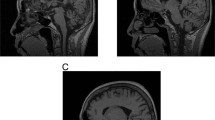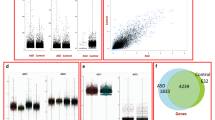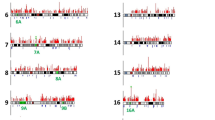Abstract
Spinocerebellar ataxia type 1 is associated with expansion of an unstable CAG repeat within the SCA1 gene. Male gametic heterogeneity of the expanded repeat is demonstrated using single sperm and low–copy genome analysis. Low–copy genome analysis of peripheral blood also reveals somatic heterogeneity of the expanded SCA1 allele, thus establishing mitotic instability at this locus. Comparative analysis of a large normal allele and a small affected allele suggests a role of midstream CAT interspersions in stabilizing long (CAG)n stretches. Within the brain, tissue–specific mosaicism of the expanded allele is also observed. The differences in SCA1 allele heterogeneity between sperm and blood and within the brain parallels the findings in Huntington disease, suggesting that both disorders share a common mechanism for tissue–specific instability.
This is a preview of subscription content, access via your institution
Access options
Subscribe to this journal
Receive 12 print issues and online access
$209.00 per year
only $17.42 per issue
Buy this article
- Purchase on Springer Link
- Instant access to full article PDF
Prices may be subject to local taxes which are calculated during checkout
Similar content being viewed by others
References
Greenfield, J.G. The spino-cerebellar degenerations (Charles C. Thomas, Springfield, Illinois, 1954).
Zoghbi, H.Y. The spinocerebellar degenerations, in Current Neurology (ed. Appel, S.H.) 121–144 (Mosby-Year Book, St-Louis, 1991).
Schut, J.W. Hereditary ataxia: clinical study through six generations. Arch. Neurol. Psychiat 63, 535–567 (1954).
Currier, R.D., Glover, G., Jackson, J.K. & Tipton, A.C. Spinocerebellar ataxia: study of a large kindred. Neurology 22, 1040–1043 (1972).
Orr, H.T. et al. Expansion of an unstable trinucleotide CAG repeat in spinocerebellar ataxia type 1. Nature Genet. 4, 221–226 (1993).
Banfi, S. et al. Identification and characterization of the gene causing type 1 spinocerebellar ataxia. Nature Genet. 7, 513–520 (1994).
Matilla, T. et al. Presymptomatic analysis of spinocerebellar ataxia type 1 (SCA1) via the expansion of the SCA1 CAG-repeat in a large pedigree displaying anticipation and parental male bias. Hum. molec. Genet. 2, 2123–2128 (1993).
Jodice, C. et al. Effect of trinucleotide repeat length and parental sex on phenotypic variation in spinocerebellar ataxia 1. Am. J. hum. Genet. 54, 959–965 (1994).
Ranum, L.P.W. et al. Molecular and clinical correlations in spinocerebellar ataxia type 1 (SCA1): Evidence for familial effects on the age at onset. Am. J. hum. Genet. 55, 244–252 (1994).
Chung, M. et al. Evidence for a mechanism predisposing to intergenerational CAG repeat instability in spinocerebellar ataxia type 1. Nature Genet. 5, 254–258 (1993).
Telenius, H. et al. Somatic and gonadal mosaicism of the Huntington disease gene CAG repeat in brain and sperm. Nature Genet. 6, 409–414 & 7, 113 (1994).
Weber, J.L. & Wong, C. Mutation of human short tandem repeats. Hum. molec. Genet. 2, 1123–1128 (1993).
Willems, P.J. Dynamic mutations hit double figures. Nature Genet. 8, 213–215 (1994).
Huntington's Disease Collabrative Research Group. A novel gene containing a trinucleotide repeat that is expanded and unstable on Huntington's disease chromosomes. Cell 72, 971–983 (1993).
Andrew, S.E. et al. The relationship between trinucleotide (CAG) repeat length and clinical features of Huntington's disease. Nature Genet. 4, 387–392 (1993).
Duyao, M. et al. Trinucleotide repeat length instability and age of onset in Huntington disease. Nature Genet. 4, 387–392 (1993).
Goldberg, Y.P. et al. Molecular analysis of new mutations for Huntington's disease: intermediate alleles and sex of origin effects. Nature Genet. 5, 174–179 (1993).
Norremolle, A. et al. Trinucleotide repeat elongation in the Huntington gene in Huntington's disease patientsfrom 71 Danish families. Hum. molec. Genet. 2, 1475–1476 (1993).
Snell, R.G. et al. Relationship between trinucleotide repeat expansion and phenotypic variation in Huntington's disease. Nature Genet. 4, 393–397 (1993).
Zuhlke, C. et al. Expansion of the (CAG)n repeat causing Huntington's disease in 352 patients of German origin. Hum. molec. Genet. 2, 1467–1469 (1993).
Koide, R. et al. Unstable expansion of CAG repeat in hereditary dentatorubral-pallidoluysian atrophy (DRPLA). Nature Genet. 6, 9–13 (1994).
Nagafuchi, S. et al. Dentatorubral and pallidoluysian atrophy expansion of an unstable CAG trinucleotide on chromosome 12p. Nature Genet. 6, 14–18 (1994).
Kawaguchi, Y. et al. CAG expansions in a novel gene for Machado-Joseph disease at chromosome 14q32.1. Nature Genet. 8, 221–228 (1994).
Nagafuchi, S. et al. Structure and expression of the gene responsible for the triplet repeat disorder, dentatorubral and pallidoluysian atrophy (DRPLA). Nature Genet. 8, 177–182 (1994).
La Spada, A.R., Wilson, E.M., Lubahn, D.B., Harding, A.E. & Fischbeck, K.H. Androgen receptor gene mutations in X-linked spinal and bulbar muscular atrophy. Nature 352, 77–79 (1991).
Strong, T.V. et al. Widespread expression of the human and rat Huntington's disease gene in brain and non-neuronal tissues. Nature Genet. 5, 259–265 (1993).
Burke, J.R. et al. The Haw River syndrome: dentatorubropallidoluysian atrophy (DRPLA) in an African-American family. Nature Genet. 7, 521–524 (1994).
Rubinsztein, D.C., Leggo, J., Amos, W., Barton, D.E. & Ferguson-Smith, M.A. Myotonic dystrophy CTG repeats and the associated insertion/deletion polymorphism in human and primate populations. Hum. molec. Genet. 3, 2031–2035 (1994).
Kunst, C.B. & Warren, S.T. Cryptic and polar variation of the fragile X repeat could result in predisposing normal alleles. Cell 77, 853–861 (1994).
Eichler, E.E. et al. Length of uninterrupted CGG repeats determines instability in the FMR1 gene. Nature Genet. 8, 88–94 (1994).
Nelson, D.L. & Warren, S.T. Trinucleotide repeat instability: when and where? Nature Genet. 4, 107–108 (1993).
Warren, S.T. & Nelson, D.L. Advances in molecular analysis of fragile X syndrome. Am. med. Assoc. 271, 536–542 (1994).
Nelson, D.L. Six human genetic disorders involving mutant trinucleotide repeats. in Genome analysis vol 7: genome rearrangement and stability, 1–24 (Cold Spring Harbor Laboratory Press, Cold Spring Harbor, 1993).
MacDonald, M.E. et al. Gametic but not somatic instability of CAG repeat length in Huntington's disease. J. med. Genet. 30, 982–986 (1993).
Zuhlke, C., Riess, O., Bockel, B., Lange, H. & Thies, U. Mitotic stability and meiotic variability of the (CAG)n repeat in the Huntington disease gene. Hum. molec. Genet. 2, 2063–2067 (1993).
Vonsattell, J-P. et al. Neuropathological classification of Huntington's disease. J. Neuropath, exp. Neurol. 44, 559–577 (1985).
Chong, S.S., Kristjansson, K., Cota, J., Handyside, A.H. & Hughes, M.R. Preimplantation prevention of X-linked disease: reliable and rapid sex determination of single human cells by restriction analysis of simultaneously amplified ZFX and ZFY sequences. Hum. molec. Genet. 2, 1187–1191 (1993).
Zhang, L. et al. Whole genome amplification from a single cell: implications for genetic analysis. Proc. natl. Acad. Sci. U.S.A. 89, 5847–5851 (1992).
Jeffreys, A.J. et al. Complex gene conversion events in germline mutation at human minisatellites. Nature Genet. 6, 136–145 (1994).
Author information
Authors and Affiliations
Rights and permissions
About this article
Cite this article
Chong, S., McCall, A., Cota, J. et al. Gametic and somatic tissue–specific heterogeneity of the expanded SCA1 CAG repeat in spinocerebellar ataxia type 1. Nat Genet 10, 344–350 (1995). https://doi.org/10.1038/ng0795-344
Received:
Accepted:
Issue Date:
DOI: https://doi.org/10.1038/ng0795-344
This article is cited by
-
Somatic CAG repeat instability in intermediate alleles of the HTT gene and its potential association with a clinical phenotype
European Journal of Human Genetics (2024)
-
Rapid and comprehensive diagnostic method for repeat expansion diseases using nanopore sequencing
npj Genomic Medicine (2022)
-
Mechanisms of genetic instability caused by (CGG)n repeats in an experimental mammalian system
Nature Structural & Molecular Biology (2018)
-
Structural signature in SCA1: clinical correlates, determinants and natural history
Journal of Neurology (2018)
-
Spinal Cord Damage in Spinocerebellar Ataxia Type 1
The Cerebellum (2017)



